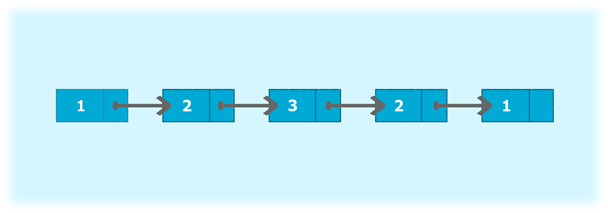Java program to determine whether a singly linked list is the palindrome
In this program, we need to check whether given singly linked list is a palindrome or not. A palindromic list is the one which is equivalent to the reverse of itself.

The list given in the above figure is a palindrome since it is equivalent to its reverse list, i.e., 1, 2, 3, 2, 1. To check whether a list is a palindrome, we traverse the list and check if any element from the starting half doesn't match with any element from the ending half, then we set the variable flag to false and break the loop.
In the last, if the flag is false, then the list is palindrome otherwise not. The algorithm to check whether a list is a palindrome or not is given below:
Algorithm
- Create a class Node which has two attributes: data and next. Next is a pointer to the next node in the list.
- Create another class Palindrome which has three attributes: head, tail, and size.
- addNode() will add a new node to the list:
- Create a new node.
- It first checks, whether the head is equal to null which means the list is empty.
- If the list is empty, both head and tail will point to a newly added node.
- If the list is not empty, the new node will be added to end of the list such that tail's next will point to a newly added node. This new node will become the new tail of the list.
a. reverseList() will reverse the order of the node present in the list:
- Node current will represent a node from which a list needs to be reversed.
- Node prevNode represent the previous node to current and nextNode represent the node next to current.
- The list will be reversed by swapping the prevNode with nextNode for each node.
a. isPalindrome() will check whether given list is palindrome or not:
- Declare a node current which will initially point to head node.
- The variable flag will store a boolean value true.
- Calculate the mid-point of the list by dividing the size of the list by 2.
- Traverse through the list till current points to the middle node.
- Reverse the list after the middle node until the last node using reverseList(). This list will be the second half of the list.
- Now, compare nodes of first half and second half of the list.
- If any of the nodes don't match then, set a flag to false and break the loop.
- If the flag is true after the loop which denotes that list is a palindrome.
- If the flag is false, then the list is not a palindrome.
a. display() will display the nodes present in the list:
- Define a node current which will initially point to the head of the list.
- Traverse through the list till current points to null.
- Display each node by making current to point to node next to it in each iteration.
Program:
Output:
Nodes of singly linked list:
1 2 3 2 1
Given singly linked list is a palindrome
|

 For Videos Join Our Youtube Channel: Join Now
For Videos Join Our Youtube Channel: Join Now










